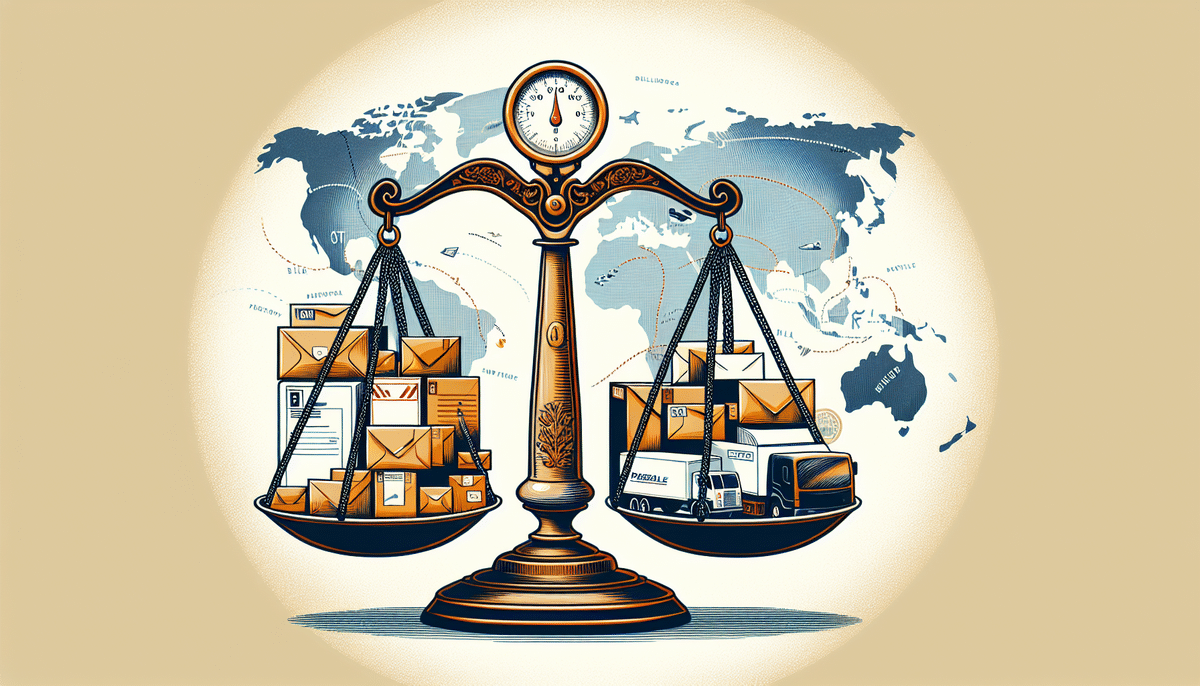How to Use Benchmarking to Negotiate Better Shipping Rates with Pitney Bowes
For businesses that rely heavily on shipping, managing transportation costs can be a major challenge. Shipping expenses can quickly add up, eating into profit margins and making it difficult to stay competitive in the marketplace. However, by using benchmarking strategies, companies can gain valuable insights into their shipping costs and identify opportunities to negotiate better rates with shipping providers like Pitney Bowes. In this article, we will explore the basics of benchmarking and outline specific tactics for using this approach to optimize your shipping strategy and reduce your transportation costs.
Understanding the Basics of Benchmarking for Negotiating Shipping Rates
Before we dive into the specifics of using benchmarking to negotiate better shipping rates with Pitney Bowes, it's important to have a clear understanding of what benchmarking is and how it works. At its core, benchmarking is the process of comparing your business's performance metrics to those of other companies in your industry. In the context of shipping, benchmarking involves analyzing your transportation costs and service levels and comparing them to those of your competitors. By doing so, you can identify areas where your shipping strategy may be falling short and pinpoint ways to improve your performance.
To benchmark your shipping operations effectively, you'll need to gather data on a variety of key performance indicators (KPIs). These might include metrics such as shipping volumes, delivery times, transit times, shipping costs, and customer satisfaction ratings. By analyzing this data and comparing it to industry benchmarks, you can gain insights into where you stand in relation to your competitors and identify opportunities for improvement.
One important thing to keep in mind when benchmarking your shipping operations is that you should focus on comparing apples to apples. In other words, you should only compare your performance metrics to those of companies that are similar in size, scope, and geography. For example, if you're a small business that primarily ships domestically, it wouldn't make sense to compare your shipping costs to those of a large multinational corporation that ships globally.
Another key consideration when benchmarking your shipping operations is to look beyond the numbers and consider the qualitative aspects of your service. For example, you may have lower shipping costs than your competitors, but if your delivery times are consistently longer or your customer service is lacking, you may still be at a disadvantage. By taking a holistic approach to benchmarking, you can gain a more complete understanding of your shipping performance and identify areas where you can make meaningful improvements.
The Benefits of Benchmarking for E-commerce Businesses
For e-commerce businesses, benchmarking can be especially valuable. Online retailers rely heavily on efficient shipping and logistics operations to deliver products to customers quickly and cost-effectively. By benchmarking their shipping performance against that of their competitors, e-commerce companies can gain a competitive edge and drive growth.
Some of the specific benefits of benchmarking for e-commerce businesses include:
- Ability to identify areas of inefficiency in shipping operations and target them for improvement
- Gaining a better understanding of market trends and shifts in shipping costs
- Providing a basis for negotiation with shipping providers to secure better rates and service levels
- Optimizing shipping strategies to improve customer satisfaction and retention
An Introduction to Pitney Bowes Shipping Services and Rates
Pitney Bowes is a leading provider of shipping and logistics services for businesses of all sizes. Their services include everything from label printing and tracking to delivery and returns management. To negotiate better shipping rates with Pitney Bowes, it's important to have a solid understanding of their pricing structure and the services they offer.
Some of the key aspects of Pitney Bowes' shipping rates and services include:
- Variable pricing based on volume, destination, and service level
- A wide range of shipping options, including ground, air, and international services
- Advanced tracking and reporting capabilities, including real-time updates on shipment status
- Flexible returns management system
By understanding these aspects of Pitney Bowes' shipping services, you can more effectively negotiate rates and service levels that match your business's needs and budget.
How to Effectively Compare Your Shipping Rates with Competitors
Now that you understand the basics of benchmarking and Pitney Bowes' shipping services, it's time to start comparing your rates and service levels to those of your competitors. This process involves collecting data on your shipping costs and service metrics and comparing them to industry averages and benchmarks.
To compare your rates with those of your competitors, you'll need to gather data on factors such as:
- Shipping volume
- Destination
- Service level
- Transit time
- Customer satisfaction
Once you've gathered this data, you can analyze it to identify areas where you may be paying more than your competitors for similar services or falling short in terms of service level or transit time. Armed with this knowledge, you can begin to negotiate with Pitney Bowes to secure better rates and improve your shipping performance.
Analyzing Your Shipping Costs: Identifying Areas for Improvement
One of the key benefits of benchmarking is the ability to identify areas where your shipping costs are higher than those of your competitors. By analyzing your transportation costs, you can gain insights into where you may be able to reduce costs and negotiate better rates.
Some common areas of inefficiency in shipping operations include:
- Carriers with high rates
- Underutilized transportation capacity
- Inefficient shipping routes
- Slow transit times
By pinpointing these areas of inefficiency and developing strategies to address them, you can reduce your shipping costs and negotiate better rates with Pitney Bowes. For example, you may be able to consolidate shipments to take advantage of bulk rates or adjust your shipping routes to reduce transit times and costs.
Tips for Negotiating with Pitney Bowes: Leveraging Your Competitive Data
Once you've analyzed your shipping costs and identified areas for improvement, it's time to start negotiating with Pitney Bowes to secure better rates and service levels. To do this effectively, it's important to leverage the data you've gathered through benchmarking to demonstrate your competitive position and identify specific areas for improvement.
Some key tips for negotiating with Pitney Bowes using benchmarking data include:
- Understand their pricing structure and service offerings to ensure you're negotiating for the right services and service levels
- Use your benchmarking data to demonstrate how your shipping performance compares to industry averages
- Identify specific areas where you can improve your performance (e.g., transit time, delivery costs) and use this as leverage in negotiations
- Be prepared to negotiate volume discounts or other concessions based on your shipping volumes and service needs
Strategies for Securing Better Shipping Rates with Pitney Bowes
When negotiating with Pitney Bowes, there are several strategies you can use to secure better rates and service levels. Some effective tactics include:
- Negotiating volume discounts based on your shipping volumes and service needs
- Asking for flat-rate pricing to simplify your shipping costs and operations
- Identifying areas where you can reduce shipping costs (e.g., by consolidating shipments) and negotiating lower rates accordingly
- Working with Pitney Bowes to optimize your shipping strategy (e.g., by adjusting your shipping routes or service levels) to reduce costs and improve performance
By using these strategies and leveraging your competitive data, you can secure better rates and service levels with Pitney Bowes and reduce your transportation costs in the long term.
Best Practices for Monitoring and Maintaining Your Shipping Costs Over Time
Once you've secured better rates with Pitney Bowes and optimized your shipping strategy, it's important to monitor and maintain your shipping costs over time. By tracking your transportation costs and service levels on an ongoing basis, you can ensure that you continue to get the best possible rates and performance.
Some best practices for monitoring and maintaining your shipping costs include:
- Regularly reviewing your shipping invoices and comparing them to your agreed-upon rates
- Tracking your shipping volumes and service levels to identify any areas of inefficiency or underutilized capacity
- Working with Pitney Bowes to address any issues that arise and optimize your shipping performance over time
Case Studies: Successful Negotiations with Pitney Bowes Using Benchmarking Tactics
To illustrate the value of benchmarking and negotiating with Pitney Bowes, let's look at some real-world examples of companies that have successfully used these tactics to reduce their transportation costs.
One e-commerce business, for example, used benchmarking data to identify areas where they were paying more for shipping than their competitors. By negotiating with Pitney Bowes to reduce their shipping rates, they were able to save over $50,000 in transportation costs in just one year.
Another company used benchmarking data to identify areas where they were falling short in terms of transit times and delivery costs. By working with Pitney Bowes to optimize their shipping strategy and negotiate better rates based on their shipping volumes, they were able to reduce their shipping costs by 20% while improving their delivery times and customer satisfaction ratings.
Tools and Resources for Streamlining Your Shipping Operations with Pitney Bowes
To streamline your shipping operations and optimize your performance with Pitney Bowes, there are a variety of tools and resources available.
Some useful resources include:
- The Pitney Bowes shipping platform, which provides real-time tracking and reporting capabilities
- Benchmarking tools and dashboards, which allow you to compare your shipping performance to industry averages and identify areas for improvement
- Consulting services and expert support from Pitney Bowes to help you optimize your shipping strategy and negotiate better rates
How to Stay Ahead of Industry Trends and Changes in Shipping Costs
Finally, it's important to stay up-to-date on industry trends and changes in shipping costs to ensure that you're always getting the best possible rates and service levels with Pitney Bowes.
Some key strategies for staying ahead of these trends include:
- Networking with other businesses in your industry to stay informed about shipping rates and trends
- Monitoring industry publications and news sources for updates on new shipping regulations or changes to carrier pricing
- Working closely with Pitney Bowes to understand their pricing structure and any changes to their service offerings
Key Metrics to Track When Analyzing Your Shipping Performance
When analyzing your shipping strategy and negotiating with Pitney Bowes, there are several key metrics to track and monitor to ensure that you're getting the best possible rates and service levels.
Some of these metrics include:
- Shipping volume and weight
- Service level and transit time
- Delivery cost per package
- Customer satisfaction ratings
By tracking these metrics and using them to compare your performance to industry benchmarks and your competitors, you can identify areas for improvement and negotiate better rates and service levels with Pitney Bowes.
Conclusion: Making the Most of Benchmarking to Optimize Your Shipping Strategy
By leveraging benchmarking data and negotiating effectively with Pitney Bowes, businesses of all sizes can reduce their transportation costs and improve their shipping performance. Whether you're just starting to analyze your shipping costs or are a seasoned shipping expert, there are a variety of tools and resources available to help you optimize your shipping strategy and drive growth in your business.
So start benchmarking, start negotiating, and start driving better shipping performance and lower transportation costs with Pitney Bowes today!









